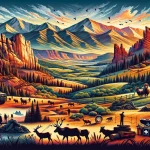The Cheyenne Tribe, one of the most influential Plains Indian tribes, has a rich cultural heritage deeply rooted in the Great Plains region of Colorado.
In This Article
TL;DR
- The Cheyenne Tribe has a nomadic history. It migrated across the Great Plains and adopted a horse-based buffalo-hunting culture.
- Their spiritual beliefs, including the sacred Sun Dance ceremony and reverence for sacred objects like the Sacred Arrows, are integral to their identity.
- Despite facing historical challenges like the Sand Creek Massacre and the Battle of Little Bighorn, the Cheyenne Tribe continues to preserve its cultural heritage and sovereignty.
Historical Roots and Nomadic Culture
The Cheyenne Tribe’s origins can be traced back to the Great Lakes region, where they lived as sedentary farmers and pottery makers. In the 17th century, they began a westward migration, eventually settling in the Black Hills region of present-day South Dakota and Wyoming. Adopting a nomadic lifestyle, the Cheyenne became skilled horse riders and buffalo hunters, adapting to the vast expanse of the Great Plains.
As they moved further west, the Cheyenne occupied lands along the Platte and Arkansas Rivers in Colorado, establishing themselves as a dominant force on the Plains. Their nomadic culture was deeply intertwined with the buffalo, which provided food, clothing, and shelter, shaping their spiritual beliefs and social structures.
Spiritual Beliefs and Ceremonies
The Cheyenne Tribe’s spiritual beliefs are rooted in a deep Native American reverence for nature and the interconnectedness of all living beings. They believe in two principal deities: the Wise One Above and a god who resides beneath the earth. One of their most sacred ceremonies is the Sun Dance, an elaborate ritual performed to honor the sun and seek spiritual renewal.
Sacred objects, like the Sacred Arrows and a buffalo hide hat, held great significance in Cheyenne culture and were carried into battle for protection and guidance. Spiritual leaders, such as Sweet Medicine, played a crucial role in preserving and passing down these beliefs and practices.
Conflicts and Resilience
As westward expansion encroached on their lands, the Cheyenne Tribe faced numerous conflicts with the U.S. government and settlers. The Sand Creek Massacre in 1864, where U.S. troops attacked a peaceful Cheyenne village, sparked widespread retaliation and further violence.
In 1867, the Treaty of Medicine Lodge assigned the Southern Cheyenne a reservation in Oklahoma while the Northern Cheyenne continued to resist relocation. The Battle of Little Bighorn in 1876, where the Cheyenne allied with other tribes to defeat Custer’s forces, became a defining moment in their struggle for sovereignty.
Despite these challenges, the Cheyenne Tribe has shown remarkable resilience, preserving their cultural heritage and advocating for their rights as a sovereign nation.
Contemporary Challenges and Triumphs
Today, the Cheyenne Tribe and the Arapaho Tribe, united as a single federally recognized tribal nation, continue to face challenges related to tribal sovereignty, reservation life, and cultural preservation. However, they have also achieved significant triumphs, such as the return of bison to tribal lands in North America as part of conservation and reparation efforts. The Office of Indian Affairs offers programs to enhance tribal governments, education, employment, and other federal programs.
Initiatives focused on education, youth engagement, and economic development aim to ensure the continuation of Cheyenne traditions while promoting self-sufficiency and sustainable practices within the community.
FAQ
How can I learn more about the indigenous people of Colorado?
The History Colorado Center hosts exhibits for multi-generational audiences, telling the story of Colorado’s history and all of its inhabitants. It houses a wealth of information about the Cheyenne people and Arapaho people, including interactive exhibits and special collections for the historic preservation of American Indian artifacts.
The Ute Indian Museum, built in 1956, includes a native plants garden, exhibits, special events, and a gift shop offering authentic Native American pottery, jewelry, and more. The museum collaborates closely with representatives of the Ute Mountain Ute Tribe, Southern Ute Tribe, and Ute Indian Tribe of Uintah and Ouray Reservation to ensure the quality of exhibits.
What is the significance of the Sun Dance ceremony to the Cheyenne Tribe?
The Sun Dance is a sacred ceremony honoring the sun and seeking spiritual renewal. It is an elaborate ritual of great cultural and spiritual importance for the Cheyenne Tribe.
How did the Cheyenne Tribe’s nomadic lifestyle shape their culture?
The Cheyenne Tribe’s nomadic lifestyle, centered around following the buffalo herds across the Great Plains, deeply influenced their spiritual beliefs, social structures, and way of life. Their culture became intertwined with the buffalo, which provided food, clothing, and shelter.
What role did the Battle of Little Bighorn play in the Cheyenne Tribe’s struggle for sovereignty?
The Battle of Little Bighorn, where the Cheyenne allied with other tribes to defeat Custer’s forces, became a defining moment in their resistance against the U.S. government’s efforts to relocate them. It symbolized their determination to protect their lands and way of life.
How are the Cheyenne and Arapaho Tribes working to preserve their cultural heritage today?
The Cheyenne and Arapaho Tribes are actively engaged in initiatives focused on education, youth engagement, and the revitalization of their language and cultural practices. They also advocate for tribal sovereignty and sustainable economic development within their communities.






